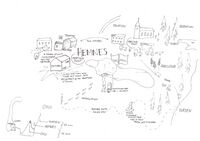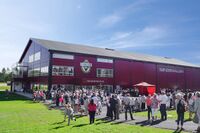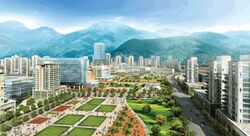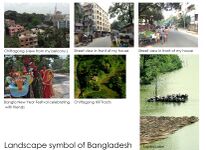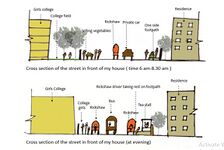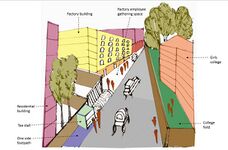LED Seminar 2016 - Landscape Symbols Reflection Group C
Landscape Symbol 1- Hemnes Norway, Helene Oppegaard
Representations and analytical drawings
in addition to your initial visual please add two further analytical drawings of your symbol
- GroupI slide3.JPG
slide 3
Søndrehallen, a symbol in my everyday landscape
The new sport hall in my community is a relative new symbol in the landscape, but it is probably the most important one. It is located near the local school and the regions heritage museum, which contains authentic rural houses with authentic content. The new sports hall is built on a voluntarily basis by the inhabitants in my municipality. This is in Norway called “dugnad”, and indicate an effort and a commitment on the local inhabitants part, to create a meeting point and a uniting sports arena for the future. The hall contains a café, which is also driven voluntarily. The café replaced the grocery store as the most important meeting place in my village and the café have become a place where the local population meet family and friends. The sports hall is meant to add a location of quality to the village and could potentially prevent depopulation and avoid centralization, which are two of the biggest problems in my municipality. The hall was built to offer a suitable sport and recreation arena for the general population, where the local schoolchildren also would be given a suitable exercise and playing arena. As the structure where built it became a bridge between generations, a common project where retirees and high schoolers alike worked together to raise the hall and make a difference in the community. Today the sports hall stands as a symbol of the amazing things cooperation produces, as well as being a high quality sports facility.
Landscape Symbol 2- Portici Bologna, Fabio Di Toro Mammarella
Representations and analytical drawings
in addition to your initial visual please add two further analytical drawings of your symbol
- GroupI slide2.JPG
slide 2
- GroupI slide3.JPG
slide 3
Reflections
Please write a 250 words text reflecting on the following questions, you can also take ideas from your group members into account
- How and why did the symbols you identify appear in your landscape?
- Did their meaning change along with socio-political, economic, environmental or cultural changes in your region, or country?
- What do these symbols mean to you today? Are they meaningful to more than just one cultural group? Are they shared across cultures?
add your text here
Landscape Symbol 3- Modernist Utopia, Michael Ajayi
Representations and analytical drawings
in addition to your initial visual please add two further analytical drawings of your symbol
- GroupI slide2.JPG
slide 2
- GroupI slide3.JPG
slide 3
Reflections
Please write a 250 words text reflecting on the following questions, you can also take ideas from your group members into account
- How and why did the symbols you identify appear in your landscape?
- Did their meaning change along with socio-political, economic, environmental or cultural changes in your region, or country?
- What do these symbols mean to you today? Are they meaningful to more than just one cultural group? Are they shared across cultures?
add your text here
Landscape Symbol 4- Tottenham, London, Daniela Ellis
Representations and analytical drawings
in addition to your initial visual please add two further analytical drawings of your symbol
- GroupI slide3.JPG
slide 3
Reflections
Please write a 250 words text reflecting on the following questions, you can also take ideas from your group members into account
- How and why did the symbols you identify appear in your landscape?
- Did their meaning change along with socio-political, economic, environmental or cultural changes in your region, or country?
- What do these symbols mean to you today? Are they meaningful to more than just one cultural group? Are they shared across cultures?
The symbols were chosen in Tottenham, North London, to show community initiatives over public buildings and spaces, their management structures and organisations. In one or many ways all of these symbols are connected to local people, history, changes, which are inspirational and educational. The most important factor is that all of these symbols have been part of a change and have become important or current through ‘necessity for change’. This change varies from change in the way goods are transported; political structures; new economic budgeting- where local authorities are selling public services, spaces and buildings to private developers; as well as new agendas for green strategy; smarter travel, smarter city. Tottenham, has been reported to be most culturally diverse area in Europe. The symbols have intercultural, intergenerational use and purpose, they target various deprived cultural groups, and work with them. The river has accommodated the student and adopted ‘arts culture as a magnet’ for the area. The skill share projects have been made to incorporate young adults and adults into getting practical experience; the gardening and allotments pockets are open to all age groups; use to be targeted more to elderly people but today we have a big amount of young people and adults which are involved, the schools regularly visit the green growing spaces and have initiated their own growing habits in the school. Claiming the public building and public space to be managed and maintained by the people would bring a new way of growing the cities, but if this become the majority , would we question its existence? “Whenever you find yourself on the side of the majority, it is time to reform (or pause and reflect).”- Mark Twain
Landscape Symbol of Bangladesh, Natasha Tourin
Representations and analytical drawings
in addition to your initial visual please add two further analytical drawings of your symbol
My Everyday landscape
Bangladesh is a country of south Asia. In north, east and west side boarded by India, Myanmar is in southeast and at the south it is facing the Bay of Bangal. As it is on tropic of cancer, Bangladesh has tropical climate with heavy rain fall, high temperature and high humidity. All this climatic character and geographical features of Bangladesh shapes people living style, behavior, culture and occupation here. In this compose image I try to portray my everyday landscape pattern as well as our cultural celebration and nature of my country. . The image at the top left is taken from my balcony. It symbolizes unplanned residential pattern due to rapid population growth in my city Chittagong. In this images it reflects unplanned building construction without respecting building law and also less concern about open spaces. Nor people neither authority are concern about this matter. Other two images beside it are both side street view in front of my house. This street has multipurpose activities. Lower income group people gathered in this street in early morning with vegetable for sell and most of the customer are middle income group people from neighboring area. This activities only occur early morning (6-8.30 am). People from neighbouring area prefer to buy from here as they can get things easily without going to the market. This street act as an income generating space and also simultaneously act as comfort space for neighbouring people and discomfort for the passer by people. There is a Girls college and one factory building located besides this street. For this reason at afternoon different activities occur in the street such as- factory worker gathered in the street at break time to have chat and to drink tea from near tea stall. Girls College ended up at evening and again this street become busy with public transport (Rickshaw, Taxi, local bus) and also with Feriwalas (Selling street foods). 1st image at bottom reflects our culture activities in Bangla New Year. People from different religion comes together and celebrate this festival with one identity “ Bangali”. Other two images shows the natural beauty of Bangladesh. Both are taken from Chittagong hill tracts. One shows the little hut of a tribal people between greenery convey the massage of hard life and in another image boats reflects the life of a fisher man.
Group reflection
Please add a summary of your group reflection here
